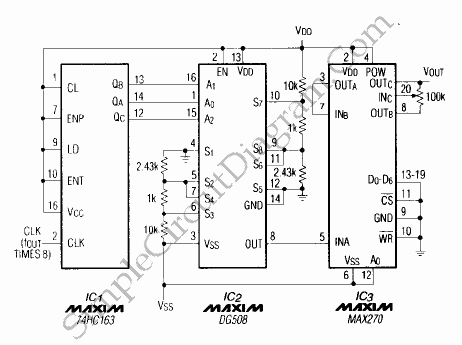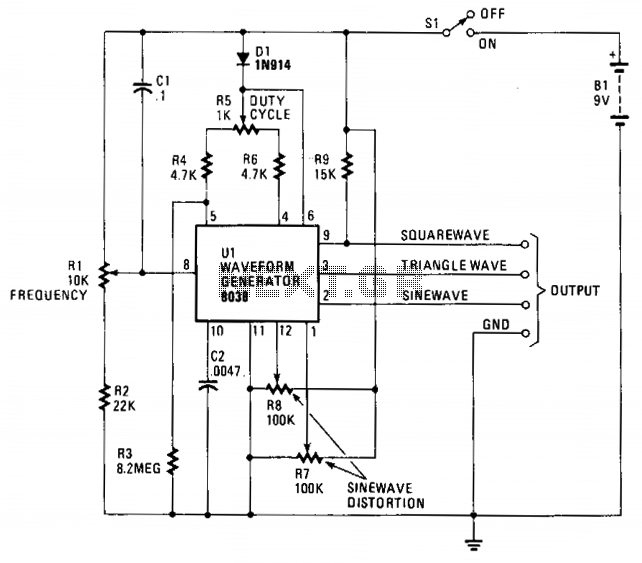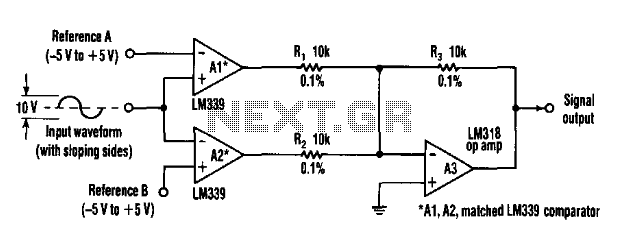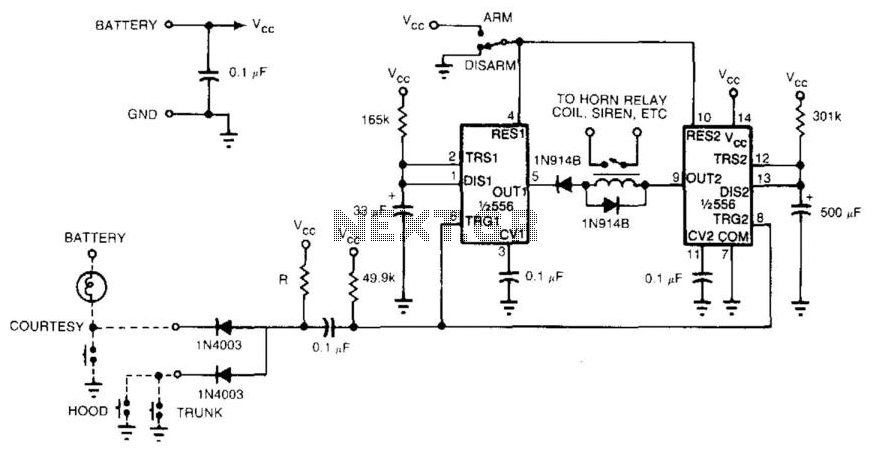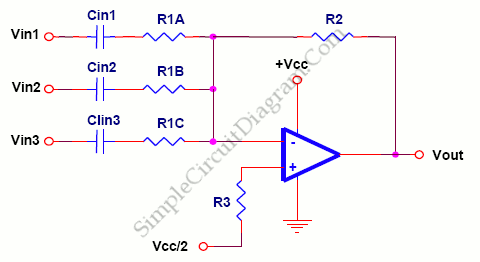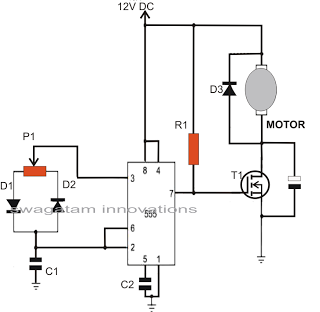
Harmonic Generator With Single Opamp
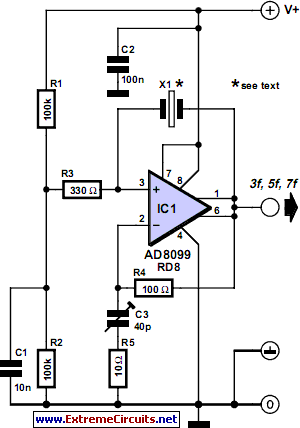
Quartz crystals exhibit a property where their amplitude and phase characteristics repeat at uneven multiples of their fundamental frequency. Overtone crystals are specifically cut to enhance this property. Any crystal can be utilized at one or more of its harmonic frequencies. Harmonic generators using transistors may function adequately at the 3rd harmonic; however, reliability decreases and frequent adjustments are required for the 5th or 7th harmonics. This circuit employs a single, fast operational amplifier (op-amp) that readily oscillates at the 3rd, 5th, or 7th harmonic. The op-amp is configured as a non-inverting amplifier, with the quartz crystal connected between its output and non-inverting input. The circuit's amplification, ideally set to unity for oscillation, is defined by the network formed by resistors R4, R5, and the trimmer capacitor C3. This network's gain is frequency-dependent, increasing with frequency. The gain can be adjusted using C3, which must be set so that the gain is insufficient for oscillation at the fundamental frequency but adequate for the 5th or 7th harmonic. A standard 10 MHz computer crystal is utilized, allowing the circuit to provide stable output frequencies between 50 and 70 MHz, which are multiples of the crystal's fundamental frequency. Tuning is accomplished using a frequency counter, with output frequency adjustments made via C3. When C3 is near the correct setting, the frequency stabilizes at the harmonic. The locking region is not precisely defined, making C3's adjustment non-critical. Once tuning is finalized, the output frequency remains crystal-stable. This circuit can theoretically operate at frequencies up to 100 MHz, although resistor values R4 and R5 may need to be reduced. If a crystal with a higher fundamental frequency, such as 15 MHz, is used, the circuit can be tuned to the 3rd harmonic, yielding 45 MHz. Testing should be conducted with a supply voltage of 5 to 9 V (the maximum supply voltage for the IC is 12 V). The peak-to-peak output voltage is approximately equal to the supply voltage minus a few volts, and the output can supply sufficient current for relatively low-impedance loads.
This circuit design effectively demonstrates the use of quartz crystals in harmonic generation, leveraging the unique properties of overtone crystals to achieve stable oscillation at desired harmonic frequencies. The configuration of the op-amp as a non-inverting amplifier allows for flexibility in tuning and frequency adjustment, making it suitable for applications where precise frequency control is necessary. The frequency-dependent gain network, composed of R4, R5, and C3, plays a crucial role in ensuring that the circuit can oscillate at the intended harmonics without falling back to the fundamental frequency.
The use of a standard 10 MHz crystal not only simplifies the circuit design but also contributes to the reliability and stability of the output frequencies. The ability to tune the circuit to higher harmonic frequencies provides versatility for various applications in communication and signal processing. The output characteristics, including the ability to drive low-impedance loads, further enhance the practicality of this design in real-world scenarios. Additionally, the consideration of supply voltage limits and output voltage characteristics ensures that the circuit can be safely integrated into larger systems without risk of damage or instability. Overall, this circuit serves as an effective solution for generating stable harmonic frequencies using quartz crystals, with broad applicability in electronic design and engineering.Quartz crystals have the property that their amplitude/phase characteristic repeats itself at frequencies that are an uneven multiple of the fundamental frequency. There are so-called overtone crystals that are cut in such a manner that they possess this property to a greater extent.
However, in principle, any crystal may be used on one or more of its harmonic frequencies. Harmonic generators based on transistors may operate satisfactorily on the 3rd harmonic, but if the 5th or 7th harmonic are wanted, the circuit becomes less reliable and requires frequent adjustment. This circuit is based on a single, fast opamp and oscillates readily at the 3rd, 5th or 7th harmonic.
The opamp is set up as a non-inverting amplifier with the quartz crystal connected between its output and the non-inverting input. The circuit amplification, which in principle must be unity to ensure oscillation, is determined by the network formed by R4, R5 and trimmer capacitor C3.
This network is frequency-dependent such that the amplification increases as the frequency rises. The network gain is adjustable with C3. The setting of the capacitor must be such that the gain is too small for oscillation at the fundamental frequency, but sufficient for, say, the 5th or 7th harmonic. The author uses a standard computer crystal of 10 MHz. Depending on the setting of C3, the circuit provides a stable output at frequencies between 50 and 70 MHz.
It should be noted that these frequencies are multiples of the series fundamental frequency of the crystal. Tuning is carried out simply with a frequency counter. The output frequency is varied with C3. When the capacitor is roughly at the correct setting, the frequency locks` as it were at the harmonic.
The area where locking occurs is not well-defined, however, so that the setting of C3 is not critical. When tuning is completed, the output frequency is crystal-stable. In principle, the circuit may be used for frequencies of up to 100 MHz, when the values of R4 and R5 may need to be reduced.
When a crystal with a higher fundamental frequency, say, 15 MHz, is used, the circuit may be tuned to the 3rd harmonic, that is, 45 MHz. The circuit should be tested with a supply voltage of 5 9 V (the maximum supply voltage for the IC is 12 V).
The peak to peak output voltage has a value of about that of the supply voltage less a few volts. The output can provide a current sufficient to drive relatively low-impedance loads. 🔗 External reference
This circuit design effectively demonstrates the use of quartz crystals in harmonic generation, leveraging the unique properties of overtone crystals to achieve stable oscillation at desired harmonic frequencies. The configuration of the op-amp as a non-inverting amplifier allows for flexibility in tuning and frequency adjustment, making it suitable for applications where precise frequency control is necessary. The frequency-dependent gain network, composed of R4, R5, and C3, plays a crucial role in ensuring that the circuit can oscillate at the intended harmonics without falling back to the fundamental frequency.
The use of a standard 10 MHz crystal not only simplifies the circuit design but also contributes to the reliability and stability of the output frequencies. The ability to tune the circuit to higher harmonic frequencies provides versatility for various applications in communication and signal processing. The output characteristics, including the ability to drive low-impedance loads, further enhance the practicality of this design in real-world scenarios. Additionally, the consideration of supply voltage limits and output voltage characteristics ensures that the circuit can be safely integrated into larger systems without risk of damage or instability. Overall, this circuit serves as an effective solution for generating stable harmonic frequencies using quartz crystals, with broad applicability in electronic design and engineering.Quartz crystals have the property that their amplitude/phase characteristic repeats itself at frequencies that are an uneven multiple of the fundamental frequency. There are so-called overtone crystals that are cut in such a manner that they possess this property to a greater extent.
However, in principle, any crystal may be used on one or more of its harmonic frequencies. Harmonic generators based on transistors may operate satisfactorily on the 3rd harmonic, but if the 5th or 7th harmonic are wanted, the circuit becomes less reliable and requires frequent adjustment. This circuit is based on a single, fast opamp and oscillates readily at the 3rd, 5th or 7th harmonic.
The opamp is set up as a non-inverting amplifier with the quartz crystal connected between its output and the non-inverting input. The circuit amplification, which in principle must be unity to ensure oscillation, is determined by the network formed by R4, R5 and trimmer capacitor C3.
This network is frequency-dependent such that the amplification increases as the frequency rises. The network gain is adjustable with C3. The setting of the capacitor must be such that the gain is too small for oscillation at the fundamental frequency, but sufficient for, say, the 5th or 7th harmonic. The author uses a standard computer crystal of 10 MHz. Depending on the setting of C3, the circuit provides a stable output at frequencies between 50 and 70 MHz.
It should be noted that these frequencies are multiples of the series fundamental frequency of the crystal. Tuning is carried out simply with a frequency counter. The output frequency is varied with C3. When the capacitor is roughly at the correct setting, the frequency locks` as it were at the harmonic.
The area where locking occurs is not well-defined, however, so that the setting of C3 is not critical. When tuning is completed, the output frequency is crystal-stable. In principle, the circuit may be used for frequencies of up to 100 MHz, when the values of R4 and R5 may need to be reduced.
When a crystal with a higher fundamental frequency, say, 15 MHz, is used, the circuit may be tuned to the 3rd harmonic, that is, 45 MHz. The circuit should be tested with a supply voltage of 5 9 V (the maximum supply voltage for the IC is 12 V).
The peak to peak output voltage has a value of about that of the supply voltage less a few volts. The output can provide a current sufficient to drive relatively low-impedance loads. 🔗 External reference
